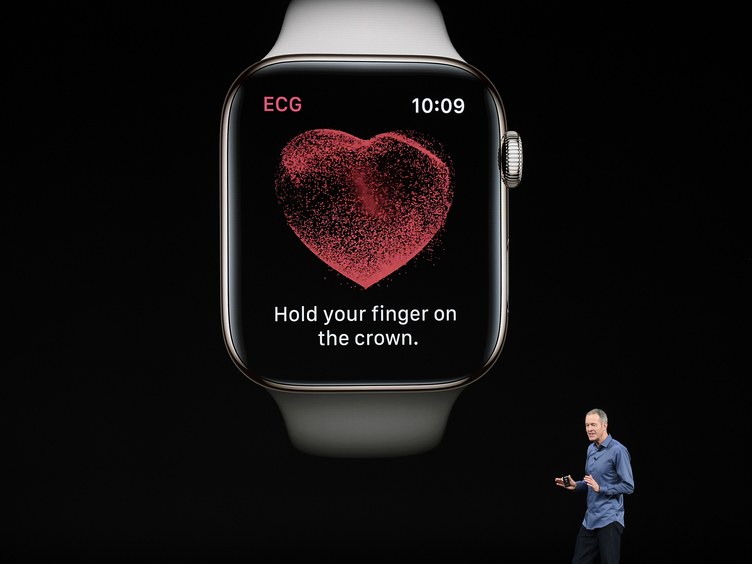Although previous editions of the Apple Watch had heart monitors, the latest Apple Watch 4 sports a more sophisticated, FDA-approved ECG (Electrocardiogram) feature which can detect atrial fibrillation (i.e irregular heart rate), measure the real-time electrical activity of the wearer’s heartbeat and generally detect heart failure. The Apple Watch 4’s ECG heart monitoring feature is so sophisticated that some cardiologists affirmed that it is way better than ECG you’d get at your doctor’s office. Apple Watch, on the other hand, can (effectively) notify you of abnormalities in your heart even if you aren’t showing any symptoms since you wear it more often and it gathers information about your heart activities. So even if there’s a slight deviation from the usual, it accurately detects it and alerts you immediately. While the feature might sound like some on-paper gimmick by to market the Apple Watch, I can assure you that it’s not. The Apple Watch, just like every other Apple product, does what it is made to do. Let’s have a look at times when the Apple Watch heart monitor has saved lives and why we think it might (literally) just be the best life-saving gadget to ever exist.
Times Apple Watch Saved Lives
Exhibit 1 (2019): “Supraventricular Tachycardia” Detection This is one of the latest occurrences that prove the efficacy of Apple Watch’s health monitors. According to a Reddit user, his Apple Watch saved his life. He was laying in bed enjoying some TV when his Apple Watch alerted him of an abnormal heart rate, even though everything was fine seconds ago. Thankfully, he put a call through to emergency response (ER) fast enough and he was rushed to the hospital. P.S: He passed out in the ambulance. Upon arrival at the hospital, he was diagnosed with Supraventricular Tachycardia. It gets more intersting. The ECG performed on him at the hospital was in line with the Apple Watch’s diagnosis; the heart chambers were beating like they should, but an abnormally fast rate. Exhibit 2 (2018): Detection of Atrial fibrillation (AFib) in 46-year old From having no previous symptoms, Ed Dentel, a 46-year-old father-of-one was informed by his Doctors that he would have suffered a fatal heart attack or stroke if his Apple Watch had not alerted him of an abnormal heart rate jump (from 60-100 beats-per-minute) to 140 bpm. Speaking to DailyMail.com, he said he would have never known about the condition without his Apple Watch. According to Dentel, his Apple Watch alerted him of irregular heart rhythm on a Thursday but he ignored the notification because he had no previous history of heart-related problems. The following day, his Apple Watch alerted him of the same irregular & rapid heart rhythm while he was having breakfast. Thinking it was an error or a fake alert, Dentel’s wife, Natalie, put the Apple Watch on their daughter’s, Kayleigh, wrist but the heart rate monitor app returned a normal rate. Putting the watch back on his wrist, the app alerted Dentel of the same irregular heart rhythm. This prompted Dentel to visit a healthcare center where he was diagnosed with Atrial Fibrillation (AFib), a rapid or irregular heart rhythm when the upper heart chambers are beating out of coordination with the lower chambers. The Doctor’s diagnosis was as exactly as the Apple Watch detected and if not for the heart monitor of his watch, Dentel’s AFib could have lead to blood clots, heart attack or stroke. Exhibit 3 (2017): Saved 50-year-old Attorney from Heart Attack But for an alert from his Apple Watch, Then Killian, a 50-year-old attorney and law enforcement agent would have died in his sleep from an heart attack. At about 1 a.m. while sleeping, Killian’s Apple Watch alerted him that his heart rate had elevated to 121 beats per minutes — from the regular average of 49 beats per minutes. This prompted him to visit a hospital where elevated enzymes that signal an impending heart attack were found in his blood after several tests were carried out. Before that night, Killian had previously been taking medical tests (of up to $10,000) and none revealed an elevated heart rate; his $199 Apple Watch did. Killian also noted that had he kept sleeping and ignored his Apple Watch’s alert, he probably would have died in his sleep. “The thing actually saved my life. I think every man 50 years old should be wearing one of these things,” Killian said. Exhibit 4 (2019): Saved an Accident Crash Victim This life-saving scenario is quite different from the one above as it isn’t medical related. Thanks to a feature on the Apple Watch, a 20-year-old Amanda Antonio was given another chance at life after her car was submerged underwater from an accident. Antonio was returning from a New Year’s Eve celebration around 4 a.m when another driver cut her off, leading her to swerve her car (which flipped several times) into a ditch filled with mud and water. Her car was getting filled with water and she couldn’t get out. She also couldn’t find her phone. Thanks to a feature of the Apple Watch (which she had on her wrist), which allows users ping their paired iPhone, she was able to find her iPhone and subsequently used it to call 911. To conclude, we believe that the Apple Watch has saved more lives than the above exhibits. That begs some questions: Is the Apple Watch the best life-saving gadget ever? What features could Apple possibily incorporate into the upcoming Apple watches that would outdo the previous versions? Have you ever used an Apple Watch? Has the device ver saved your life? Or perhaps done something similar?



